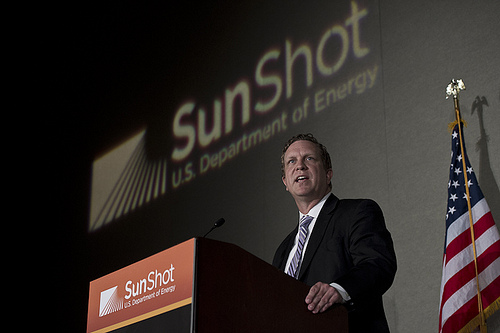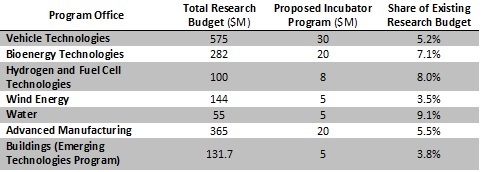
DOE Proposes Expanding High Impact Energy Innovation Incubator Program

Buried in the President’s FY2014 budget proposal is an interesting reform that could impact energy innovation without relying on Congress for any new – and hard to come by – federal investments. The idea is to create eight new research incubator programs at the Department of Energy that forge collaborations with early-stage start-ups to bring promising new ideas closer to commercial scale. In particular, the incubators would focus on promising technology pathways DOE is not currently investing in.
The incubator programs would be housed within each of the energy technology offices (except for geothermal) and leverage a small share of existing research budgets. The figure below provides the proposed budgets for the new incubators. (Note, the DOE is also continuing its existing solar incubator program.)
Each incubator is expressly aimed at emerging areas of research and technology development not “supported in any meaningful” way by existing DOE projects.
For example, the Vehicle Technologies Program wants to focus on advanced power electronics and electric motor ideas. The Advanced Manufacturing Program wants to invest in “revolutionary” technology pathways that cut energy-use in production, but also make U.S. manufacturers more competitive. And the Bioenergy Technologies Program wants to support novel thermochemical approaches to producing low-carbon fuels.
The goal is to invest small sums of public research dollars to help overcome barriers to moving a new idea from proof-of-concept to pre-commercial pilot scale. In practice, this means moving new ideas that have proven feasible through laboratory experiments and early small-scale technology mock-ups, but must also be tested at larger scale. If successful, these start-ups could rapidly commercialize and deploy.
Unfortunately, doing so is not as simple as taking a small laboratory experiment and making it bigger. Rather, creating pilot projects of novel technologies often requires new materials, chemical processes, and engineering designs that may not already exist and require significant research the start-ups may not have the unique technical capabilities or funding to do. The incubators can offer solutions to these barriers by collaborating with start-up researchers to use public research equipment and infrastructure at a National Lab, make use of Lab scientists and engineers, and invest in breakthrough research the private sector is unwilling to fund even though it’s required to prove commercial viability.
This model has already proven successful at DOE. In 2007, the DOE created a Solar Incubator Program to accelerate the transition of next-generation solar start-ups to commercial scale with small grants for 12 to 18 month long projects. Since then the program has invested $92 million in 54 projects (and recently announced $12 million in more funding), which helped advance a number of technologies to pilot-scale and spurred $1.7 billion in follow-on venture capital and private sector investment. And while the incubator awards grants, the start-ups are also required to share between 20 and 50 percent of project costs. The eight proposed incubators would be directly modeled after its solar brethren.
As with any high-risk investment, some of these incubator projects may commercially succeed and others may not. The Solar Incubator was no different. On the one hand, the incubator successfully assisted PrimeStar Solar in piloting their next-generation thin-film solar design, which ultimately led General Electric (GE) to purchase the company with plans to manufacture the solar panels. GE eventually scrapped those plans and decided to further develop the thin-film technology after unfairly subsidized Chinese solar panels flooded the market at below-cost prices. Similar market issues derailed incubator graduates Abound Solar and impacted thin-film producer SoloPower. On the other hand, incubator alumni 1366 Technologies is a leading solar manufacturing company, Alta Devices recently demonstrated the most efficient dual junction solar cell in the market, and concentrating solar company Solaflect Energy is moving toward commercial demonstration of its heliostat mirror technology.
In all cases, the projects significantly advanced solar innovation towards cheaper and better technologies by broadening the DOE’s investments beyond the research pathways it is already investing in, commercial success or not. This is a crucial point because with all public funding, not all potential projects can be invested in. Choices must be made because of limited federal dollars. That means only some high-risk research approaches can be focused on at any one time. For instance, ARPA-E receives thousands of high-quality research proposals in response to their funding announcements yet is only able to support a select few because it’s underfunded. The incubator programs would allow the DOE to invest in more high-risk projects without straining its research budgets during times of budget austerity to the benefit of U.S. energy innovation. And it also acts as a vital feedback loop into existing research programs by informing whether new research approaches should be invested in and how best each technology office can invest its portfolio to maximize innovation.
Of course, the energy incubators still won’t make up for the sobering fact that the United States continues to chronically underinvest in innovation. Nor do the incubators aim to. Ultimately, the United States must dramatically increase funding in energy innovation to make a low-carbon future possible. But it’s important to note that even in times of declining research budgets there are still ways to spur more energy innovation. The proposed energy innovation incubators are one of these ways.
Originally posted on Energy Trends Insider.
Photo: Assistant Secretary of EERE David Danielson introduces the Sunshot incubator program in 2012 at the Sunshot Grand Challenge Summit and Technology Forum.


